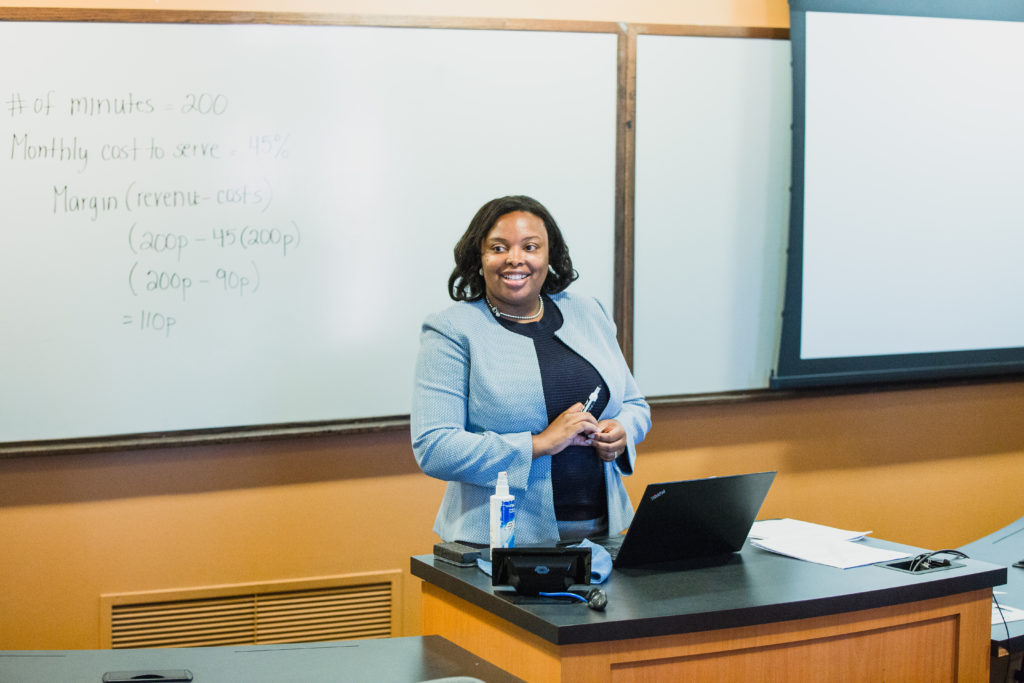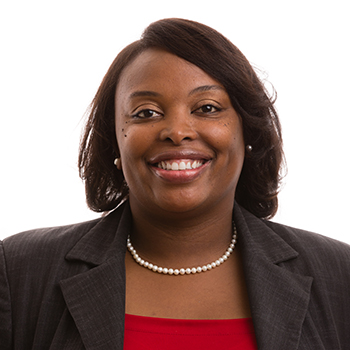Crummer Professor Dr. Tracy Kizer Makes the Case for Inclusion and Emotional Intelligence during Black History Month

Associate Professor of Marketing Dr. Tracy Kizer reflects on George Floyd’s “I can’t breathe” and hopes it serves as a lesson in emotional intelligence for everyone.
By Laura J. Cole ’04 ’08MLS
For Dr. Tracy Kizer, the call for inclusion is really a call to empathize with and celebrate each other.
“I see the world as a series of individuals with various pieces of their own humanity that they bring—which is also how I see diversity, equity, and inclusion, too. It’s simply a celebration of each other’s lived experiences,” said Dr. Kizer, an Associate Professor of Marketing at the Crummer Graduate School of Business.
It’s why she’s committed to doing anti-racism work. In addition to recently leading a diversity, equity, and inclusion seminar for tech company Progress’ 5,000 global employees, she has also been facilitating an Anti-Racism Learning Group at Rollins. The goal for both is no different than the lessons she teaches students about branding themselves: to express rather than impress.

“Let the whole world see who you are and invite them in. I think that really is the core of diversity, and why it’s so important here at Crummer,” she said.
Kizer has experienced many instances of being treated with kindness and humanity. One of the most transformative came during her final year as a student at Crummer. That fall, September 11th happened. Then, in January, her mother died.
She was overwhelmed with grief and was worried about how she would be able to get through the semester. Kizer said she is thankful that instead of emphasizing her studies, her Crummer professors, especially former professor Dr. Carol Anderson, gave her the space to emote and cry—and ultimately to exhale.
“My final academic year at Crummer was very much life-changing,” she said. “It is then that I began to reflect not only on my journey but where I was supposed to be and what life actually meant.”
It’s part of why she changed career trajectories from engineering to marketing, and why she’s hoping this Black History Month is a reminder to pause and listen to—and learn from—each other.
“My hope for Black History Month 2022 is that more people realize diversity and social justice are both positive sum games. No one loses in the end,” she said. “I think it’s our imperative to be humane and kind to each other, so that we can make a better society for all people.”
We sat down with Kizer to learn more about her work to combat racism, the role of emotional intelligence in learning, and why she thinks inclusion is as important in the classroom as it is in the boardroom.
You’re part of the Anti-Racist Learning Group on campus. Tell me a little bit about how that came about and how you became a part of it.
Professor Kizer: After the death of George Floyd, there seemed to be a collective consciousness in this country. Like many of my other African-American friends, I turned inward. We began to self-reflect and that self-reflection led to the identification of a lot of suppressed trauma—a lot of suppressed pain. His “I can’t breathe” became a rally cry for every time we were discriminated against, every time we were marginalized. In that moment many of us realized that we had not healed from our trauma because we had suppressed it for so long.
During that time, Crummer initiated a racial justice convening group for faculty and students. I sat out because I needed to heal. I was paralyzed with my own pain. After about six months or so of healing and doing my own work, the university announced the Anti-Racism Learning Groups, and I decided to start there with trying to walk through my pain with my colleagues.

I joined a group led by [English Professor] Emily Russell, who was amazing. I was the only person of color in my group, and I didn’t feel the obligation to inform everyone else about my Blackness. I felt the need to just understand their whiteness and understand where they were because oftentimes we don’t talk to each other about what we’re feeling. It became very therapeutic and very powerful to hear my colleagues openly express their lack of knowledge, their confusion, their lack of clarity, and their general fear.
This year, I decided to be a facilitator of an Anti-Racism Learning Group because I really enjoyed the experience last year. The group I’m facilitating is all people of color. There’s me who’s African-American, a graduate student who’s Haitian-American, and three staff members who all identify as LatinX. Having those conversations bi-weekly feels like sitting on a living room couch with your family and talking about ways that we have encountered racism and how we support efforts of anti-racism in our work circles, our family circles, and just generally in the community. It’s a very rich dialogue every week, and we help each other through trials.
You clearly had two different experiences with the Anti-Racism Learning Group. The first time, you were the only person of color, and now you’re among a group of people of color. Did you feel you had to do a lot of the heavy lifting and listening previously? Has there been a shift between the two experiences for you?
Professor Kizer: Actually, the first time around I didn’t do a lot of heavy lifting. That’s one of the things that I fully believe in. I can only speak to my own experience. I don’t speak for all Blacks, which is where the lifting comes in sometimes. It became a space where people shared, but I wasn’t there to educate. I was just there to listen and learn.
I do think in the second group we are able to more openly share our frustrations. We talk about the attacks on our identity. We wonder aloud why we have to constantly deal with these things. The lift there is more of a support lift and also figuring out ways how to exercise our power and authority to help others be anti-racist. That’s a lot of work. It’s a very heavy lift for anyone—no matter what your racial identity—to teach someone to be an anti-racist or to stop racist behavior.
You’ve talked about how former Crummer professor Dr. Carol Anderson taught you the importance of connecting with your emotions, which may not always be valued in a business setting. Can you talk a bit what that meant and the role emotional intelligence plays in your life today?
Professor Kizer: Certainly, I credit Dr. Anderson with the friendship and mentorship as a faculty member to help me exhale, but my parents taught me how to deal with my emotions and my mother always encouraged and allowed me to exhale, especially after my father passed away when I was 17.
Emotional intelligence really is understanding how to connect and empathize with others. My emotional intelligence becomes a source of either grounding myself from being hurt, disappointed, or saddened—or to really connect with a student who has an experience that resonates with me and I with them. It becomes a mutual connection, and it is so very important with understanding the lived experience of other people. If I were to teach a diversity, equity, and inclusion course, I would put emotional intelligence right at the front of it because how we understand and manage our emotions when we hear other people’s experience is so important.
For example, in my anti-racism group that first year, we were talking about police brutality, and a white counterpart said if people would just follow the rules and do what the police said, they wouldn’t be getting shot or murdered. That’s what they believe, but there was no empathy, no emotional intelligence in that statement. So I shared that my brother is in law enforcement. He had to teach my six nephews how to respond if they’re pulled over because if they’re all in one car at the same time, it can be very dangerous for them. He taught them how to move inside of the car, so that they don’t look like they’re reaching for a gun. He taught them how to be overly respectful. This is training that I’m pretty sure a lot of white families don’t have to do.
Some people in the group were very shocked that Black families have to train our young boys how to respond to police because we don’t want them accidentally shot for just being themselves. In that moment, I realized that if we just take the time to empathize with the humanity of other people versus judging it, we can make strides in how we come together in diverse workspaces.
I’m sure you had to exhale after that conversation. How important do you think exhaling is terms of the learning process or even in the work environment?
Professor Kizer: That’s a great question. From a learning perspective, I always tell students, myself, and even my son: give yourself room to make mistakes. Just focus on the learning. I believe that your emotions have very little space when you’re trying to learn—except if it’s difficult. Then you have to press through and not forget to breathe along the way. You have to figure out how to be cyclical in inhaling, exhaling, and emoting, so that you can be at your absolute best self and not get too overwhelmed by your circumstances. There’s no recipe for that.
I think that’s great advice overall. What differences have you seen at Rollins or Crummer since when you were a student nearly 20 years ago versus now? In what ways do that you think the College still has to grow?
I’ll just be very honest with you. There are a lot of similarities from when I was a student.
But I’m hopeful because of the overall strategic priority on DEI initiatives and the Anti-Racist Learning Groups on campus. I think they will shift the culture because more people are interested in shifting the culture. I didn’t see that as a student 22 years ago, but now I see all people from different identities—whether that’s race, sexual orientation, or religious observance.
I am proud that we are moving towards that space, but there’s still room for improvement. I would like to see us have a leadership position focused on diversity that can help with the organizational strategy for all units on campus. And we still need more students from marginalized identities to become a part of the Rollins fabric.
Until then, what would you say is the business case for students who may not see the value in doing anti-racist work on top of their studies and everything else they may have going on?
Professor Kizer: That’s an easy one. The business case is that most companies remain competitive because of innovation. Innovation can only be fostered through diverse perspectives. The research has shown that teams with individuals from different backgrounds—whether race, ethnicity, age, ways of thinking—foster and fuel innovation inside of organizations. They become a source of competitive advantage.

